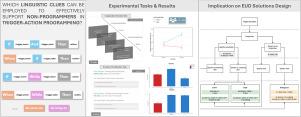Making trigger-action rules more comprehensible: Investigating which linguistic clues effectively guide non-programmers
IF 5.1
2区 计算机科学
Q1 COMPUTER SCIENCE, CYBERNETICS
International Journal of Human-Computer Studies
Pub Date : 2025-09-20
DOI:10.1016/j.ijhcs.2025.103613
引用次数: 0
Abstract
Trigger-Action Programming is a commonly used paradigm in End-User Development interfaces, allowing users without programming experience to create new automation systems. Even if considered easy to grasp, this approach poses some challenges: non-programmers often confuse events (instantaneous occurrences) and states (prolonged occurrences), leading to critical errors in the definition of triggers. Although past research has already questioned the effectiveness of the typical if-then structure, there is a limited exploration of which specific linguistic cues might help or hinder users from distinguishing between events and states. Our study, involving 85 non-programmers, examines a broader pool of linguistic aspects, investigating (i) preferences for conjunctions and verbs when describing events and states and (ii) which conjunctions help users accurately differentiate these occurrences. Our results indicate that while participants tended to prefer temporally specific language, such as ”when” for events and ”while” for states, some of these conjunctions, like ”when”, may not support users in accurately identifying and differentiating events from states, similar to the generic ”if”. These findings underscore the role of specific language on non-programmers’ comprehension and mental representations of triggers. Designing interfaces with more easily graspable linguistic cues and mapping them at the system level may help guide non-programmer users in correctly structuring trigger-action rules.

使触发-操作规则更易于理解:调查哪些语言线索可以有效地指导非程序员
触发-动作编程是终端用户开发界面中常用的范例,允许没有编程经验的用户创建新的自动化系统。即使被认为很容易掌握,这种方法也带来了一些挑战:非程序员经常混淆事件(瞬时发生)和状态(长时间发生),从而导致触发器定义中的严重错误。尽管过去的研究已经对典型的if-then结构的有效性提出了质疑,但对于哪些特定的语言线索可能有助于或阻碍用户区分事件和状态的探索却很有限。我们的研究涉及85名非程序员,研究了更广泛的语言方面,调查了(i)在描述事件和状态时对连词和动词的偏好,以及(ii)哪些连词可以帮助用户准确区分这些情况。我们的研究结果表明,虽然参与者倾向于使用时间特定的语言,例如用“when”表示事件,用“while”表示状态,但其中一些连词,如“when”,可能无法支持用户准确识别和区分事件和状态,类似于通用的“if”。这些发现强调了特定语言在非程序员对触发器的理解和心理表征中的作用。设计带有更容易理解的语言线索的界面,并将其映射到系统级别,可能有助于指导非程序员用户正确构建触发-操作规则。
本文章由计算机程序翻译,如有差异,请以英文原文为准。
求助全文
约1分钟内获得全文
求助全文
来源期刊

International Journal of Human-Computer Studies
工程技术-计算机:控制论
CiteScore
11.50
自引率
5.60%
发文量
108
审稿时长
3 months
期刊介绍:
The International Journal of Human-Computer Studies publishes original research over the whole spectrum of work relevant to the theory and practice of innovative interactive systems. The journal is inherently interdisciplinary, covering research in computing, artificial intelligence, psychology, linguistics, communication, design, engineering, and social organization, which is relevant to the design, analysis, evaluation and application of innovative interactive systems. Papers at the boundaries of these disciplines are especially welcome, as it is our view that interdisciplinary approaches are needed for producing theoretical insights in this complex area and for effective deployment of innovative technologies in concrete user communities.
Research areas relevant to the journal include, but are not limited to:
• Innovative interaction techniques
• Multimodal interaction
• Speech interaction
• Graphic interaction
• Natural language interaction
• Interaction in mobile and embedded systems
• Interface design and evaluation methodologies
• Design and evaluation of innovative interactive systems
• User interface prototyping and management systems
• Ubiquitous computing
• Wearable computers
• Pervasive computing
• Affective computing
• Empirical studies of user behaviour
• Empirical studies of programming and software engineering
• Computer supported cooperative work
• Computer mediated communication
• Virtual reality
• Mixed and augmented Reality
• Intelligent user interfaces
• Presence
...
 求助内容:
求助内容: 应助结果提醒方式:
应助结果提醒方式:


